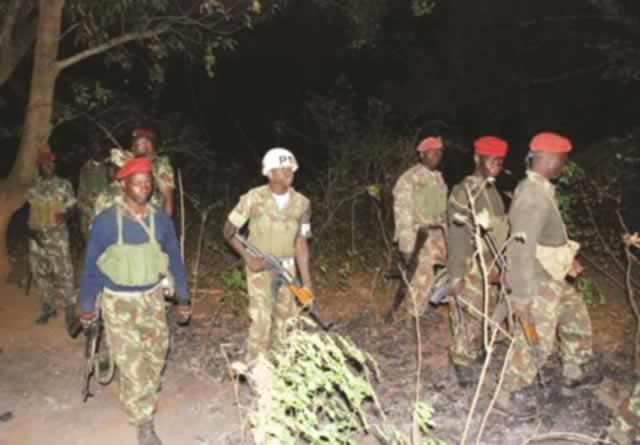Renamo must be stopped in its tracks


Mozambican government soldiers patrol an area in Gorongosa in central Mozambique in July this year. – AFP
Isdore Guvamombe Features Editor
Mozambique is one of the 14-member states of Sadc and the recent commencement of armed hostilities between the Government and the Mozambican National Resistance Army, abbreviated Renamo, is the re-ignition of a conflict that might once again, destabilise the region.
The conflict in Mozambique should be viewed in the context that the country shares borders with seven of the 14 Sadc countries and then there is a regional transport hub presented the country’s vast frontage.
Mozambique is bordered by the Indian Ocean in the east and Malawi, South Africa, Swaziland, Tanzania, Zambia, and Zimbabwe and it shares maritime borders with the Comoros, Madagascar and Mayotte Island (France).
Since the end of the civil war in 1992, Mozambique and indeed its neighbours and the region have enjoyed peace and stability.
There is no doubt that in recent years Sadc has grown from strength to strength in terms of fostering regional development and integration, owing to the largely peaceful environment and mortgaging the region to the whims of a rebel movement like Renamo is tantamount to reversing all the gains made so far.
The conflict needs to be nipped in the bud stage to allow continued stability and development in the region where peace and stability are critical.
It is very critical for all and sundry to understand that in the heyday of the first civil war that ended in Mozambique in 1992, a hodgepodge of political, social and economic factors were involved in a manner that makes the second coming of the conflict a complex and unpalatable concoction for disaster.
At the height of Zimbabwe’s war of liberation between 1976 and 1977, Rhodesian troops repeatedly entered Mozambique in order to raid Zanla bases hosted by the Frelimo government.
The idea was to thwart Zanla’s growth as a liberation movement and kill its cadres and morale before they crossed into Zimbabwe for combat.
In this context, Frelimo ex-official Andre’ Matsangaissa defected and was given military training and installed as leader of Renamo, which had been founded by the Rhodesian secret service shortly before. This is where the name Matsanga, used interchangeably with Renamo by ordinary citizens of Sadc came from.
Renamo thereafter started operating in the Gorongosa area in order to fight Frelimo and Zanla. However, in 1979 Matsangaissa died in Renamo’s unsuccessful first attack on a regional centre in Villa Paiva and Renamo was subsequently ousted from the area.
Thereafter, Afonso Dhlakama took over as the new leader of Renamo and transformed it into a guerilla army.
Having fought the Portuguese using guerilla strategies, Frelimo was now forced to defend itself against the very same Renamo and the Rhodesian Special Service.
It had to defend vast areas and hundreds of locations, while Renamo operated out of a few remote areas carrying out raids against towns and important infrastructure, with the aid of the Rhodesians.
In no time Renamo systematically forced civilians into its employment. This was done by mass abduction, especially of children in order to use them as soldiers. It is estimated that one third of Renamo military force that time were child soldiers. But abducted people also had to serve Renamo in administrative or public service functions in the areas it controlled.
Renamo also came up with another way of using civilians for military purposes called Gandira. This system especially affected the rural population in areas controlled by Renamo and forced them to fulfill three main tasks.
The first was to produce food for Renamo. The second was to transport goods and ammunition and the third was for women to serve as sex slaves.
At the height of the first conflict both sides heavily relied on the use of land mines.
Renamo was introduced to land mines by Rhodesians who used the same to seal off the country’s border with Mozambique in a desperate attempt to thwart continued Zanla infiltration while Renamo used the land mines to terrify the populace, stall the economy and destroy the civil services, mining roads, schools and health centres.
Frelimo also needed the land mines and used them as a means to defend important infrastructure.
Thus, despite its far superior numbers, Frelimo was unable to adequately defend any but the most important cities. By the mid-1980s, the government had lost control of much of the countryside. Renamo was able to carry out raids virtually anywhere in the country except for the major cities. Transportation became a perilous business. Even armed convoys were not safe from Renamo attacks.
Cornered, Frelimo reacted by reusing a system first introduced by the Portuguese, the former colonisers that is, the creation of fortified communal villages called Aldeamentos where much of the rural population was relocated.
Furthermore, in order to keep a minimum level of infrastructure working, three heavily guarded and mined corridors were established consisting of roads, railways and power lines: the Beira, the Tete (also called the Tete Run which speaks for itself regarding its safety) and the Limpopo corridors.
The Frelimo Government also enlisted foreign support and intervention. It initially received substantial military and development aid from Russia, then USSR and later additionally from France, the United Kingdom and the USA.
In the US, conservative circles lobbied for the support of Renamo but were opposed by the State Department which finally gained the upper hand. Renamo received military support from Rhodesia, South Africa, Malawi and Kenya as well as organisational support from the then West Germany.
In 1982, a newly independent Zimbabwe understood that it was landlocked and needed Mozambique’s sea frontage as a trade route.
So Zimbabwe intervened in the civil war in order to secure its transport ways, stop cross-border Renamo raids and help its old ally Frelimo.
Zimbabwe’s help was crucial to the defense of the corridors.
Later Zimbabwe became engaged further, carrying out several joint operations with Frelimo against Renamo strongholds.
Renamo was battered to the point of giving up its base camps in the Gorongosa area.
It should also be understood that after the fall of the Smith regime in Rhodesia and the birth of Zimbabwe, apartheid South Africa became Renamo’s main ally.
President Samora Machel, was economically ruined by the civil war and as a result, he reluctantly signed a non-aggression pact with South Africa, known as the Nkomati Accord.
In return, South Africa promised to sever economic ties in exchange for Frelimo’s commitment to prevent the ANC from using Mozambique as a base to pursue its campaign to overthrow white minority rule in South Africa.
The volume of direct apartheid South African government support for Renamo diminished after the Nkomati Accord, but documents discovered during the capture of Renamo headquarters at Gorongosa in central Mozambique in August 1985 revealed continuing South African government communications and military support for Renamo.
By the end of the 1980s Renamo had failed to capture any large cities but it terrorised rural areas in both Zimbabwe and Mozambique.
Frelimo controlled the urban areas and the corridors, but was unable to protect the countryside from Renamo squadrons.
In a twist of events, on October 19, 1986, Mozambique president Machel died when his presidential aircraft crashed near South Africa’s border. There were accusations and counter-accusations and even today, there is no agreement on who killed him although apartheid South Africa is the chief suspect.
President Machel was succeeded by Joaquim Alberto Chissano, then Foreign Minister since independence in 1975.
Chissano literally continued with Machel’s policies of expanding Mozambique’s international ties, particularly the country’s links with the West, and pursuing internal reforms.
It is on record that Renamo systematically committed war crimes and crimes against humanity as part of its destabilisation strategy.
Among them were mass killings, rape and mutilation of non-combatants during terrorist raids on villages and towns, the use of child soldiers and the employment of the Gandira system, based upon forced labour and sexual violence.
Often women were captured from the fields or laundry points along rivers and raped as a means to boost troop morale.
Gandira caused widespread starvation among the rural population due to the little time left to produce food for themselves.
This caused more and more persons to be physically unable to endure the long transportation marches demanded from them.
Refusing to participate in Gandira or falling behind on the marches resulted in severe beating and often execution.
Those who attempted to flee were punished harshly. The most gruesome practice was the mutilation and killing of children left behind by escaped parents.
These crimes attracted worldwide attention, especially an incident in which Renamo soldiers butchered 424 civilians, including the patients of a hospital, with guns and machetes during a raid on the rural town of Homoine.
Most of the civilians were victims of purposeful shooting deaths and executions, of axing, knifing, bayoneting, burning to death, forced drowning and asphyxiation, and other forms of cruel murder.
This is precisely the reason why Renamo must be stopped today and not tomorrow.
If it is allowed to go back to its ways, it will cause more harm in its second coming given the new world political, economic and social order.








Comments